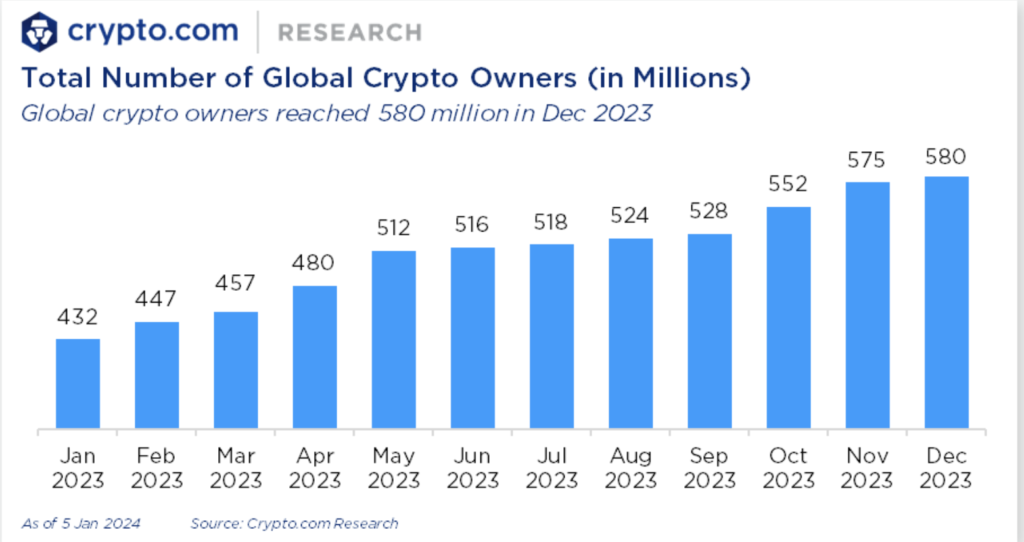As Bitcoin goes through its 4th pivotal halving event, the landscape of cryptocurrency has transformed significantly. This new financial territory brings key changes and developments surrounding Bitcoin’s halving, from the unprecedented pre-halving price surges to the enhanced global decentralisation and security of its network
Bitcoin halving has catalysed a surge in crypto adoption
Since the Bitcoin halving event in May 2020, the number of people using cryptocurrencies worldwide has skyrocketed by at least 400%, growing from about 100 million to nearly 580 million users by the end of 2023.
This dramatic increase in user base is drawn from estimates by the Cambridge Centre for Alternative Finance and Crypto.com.
Although the rate at which new Bitcoins are generated has slowed down due to the halving process, global interest and adoption of cryptocurrencies have not decreased.
As of early 2024, data suggests that roughly 2.7% of the world’s population owns Bitcoin, amounting to about 219 million individuals.
This represents a significant rise—approximately 208%—from the 71 million Bitcoin users estimated four years earlier. It’s important to note, however, that these figures are estimates; accurately gauging the exact number of Bitcoin or other cryptocurrency users is challenging.
Factors like the inability of on-chain transaction analysis to distinguish between active users, long-term holders, and lost coins make precise counts difficult.

Source: Crypto.com
Bitcoin’s pre-halving price rally in 2024
The 2024 pre-halving period has shown unprecedented growth in Bitcoin’s price, marking a distinct difference from the previous three halving events.
Historically, significant price surges in Bitcoin occurred after the halving, with new all-time highs typically forming about a year later.
For instance, before the 2020 halving, Bitcoin did not surpass its previous peak of $20,000. It only exceeded this mark 10 months post-halving.
However, the scenario has dramatically changed in the current cycle.
Bitcoin achieved a new all-time high just before the upcoming halving, hitting a record price of $73,600 on March 13, 2024. This kind of price action prior to a halving is unprecedented and has been noted by several analysts.
How Bitcoin miners are better positioned ahead of the 2024 halving
This time around, the unprecedented surge in Bitcoin’s price before the halving may have bolstered the mining industry, granting miners greater control over their operational costs.
Miners seem to be in better financial standing compared to previous halving cycles, with reduced debt levels and improved cost management, particularly in electricity expenses.
Moreover, the price appreciation preceding the halving is a novel occurrence in Bitcoin’s history, providing an additional boon to miners.
Since the third halving in May 2020, Bitcoin’s mining energy consumption has notably risen, reaching 99 Terawatt hours (Twh) by April 18, 2024. Despite this increase, there’s a positive trend in the utilisation of renewable energy sources for Bitcoin mining, accounting for 54.5% of the network’s energy consumption as of January 2024, up from 39% in September 2020, according to Bitcoin ESG Forecast and CCAF data, respectively.
The first Bitcoin halving with active spot ETFs in the U.S.
The 2024 Bitcoin halving stands out as the first to occur alongside active spot Bitcoin ETFs (exchange-traded funds) in the United States, marking a significant evolution in Bitcoin investment accessibility.
These ETFs, which began trading in January 2024, have opened the doors for institutional investors to engage more directly with Bitcoin.
Bloomberg’s ETF analyst, Eric Balchunas, reported that these spot Bitcoin ETFs have achieved “blockbuster success,” indicating a sharp rise in Bitcoin demand. Since their inception, the combined holdings of all ten spot Bitcoin ETFs have increased by at least 220,000 BTC, valued at approximately $14 billion.
Among these, BlackRock’s spot Bitcoin ETF has seen the most substantial inflows, with its holdings skyrocketing more than 10,000% from an initial 2,621 BTC to 273,140 BTC as of April 18.
As for the broader market dynamics, while the halving is significant, it should be viewed as part of a larger narrative that includes ETFs, quantitative easing, and other factors shaping the market’s future.
Bitcoin’s global decentralisation and enhanced security
Bitcoin’s network has seen substantial improvements in security and decentralisation over the past few years.
Previously concentrated primarily in mainland China, where nearly 80% of the mining activity took place as of 2020, the Bitcoin mining landscape has now become significantly more global.
As of February 2024, the United States leads with 40% of the total mining hash rate, followed by China and Russia, which contribute 15% and 12%, respectively, according to Hashlab Mining.
This shift toward geographic decentralisation continues as miners explore regions like Africa and Latin America, which are attracted by lower electricity costs.
Moreover, the security of the Bitcoin blockchain has dramatically increased; its hash rate has quintupled since the last halving, making the network much more robust against attacks.
Now, it requires five times more computing power and associated resources such as electricity, infrastructure, and hardware to pose a threat to the network.

